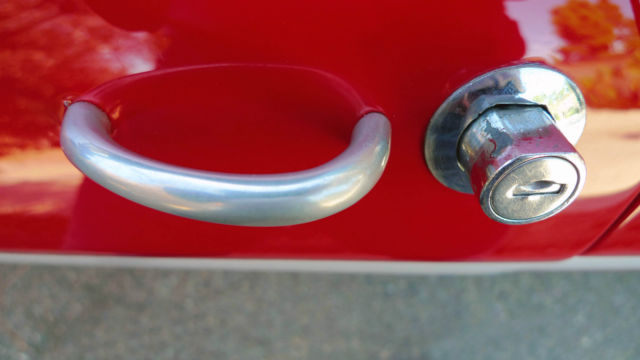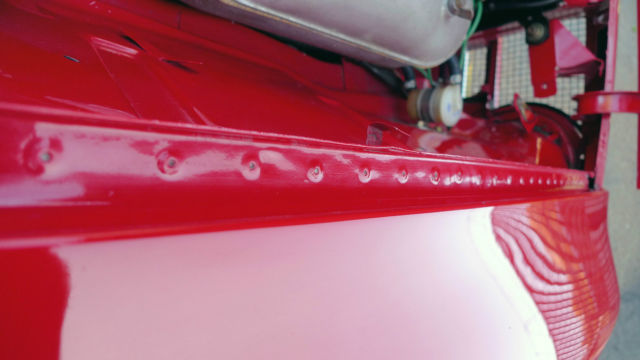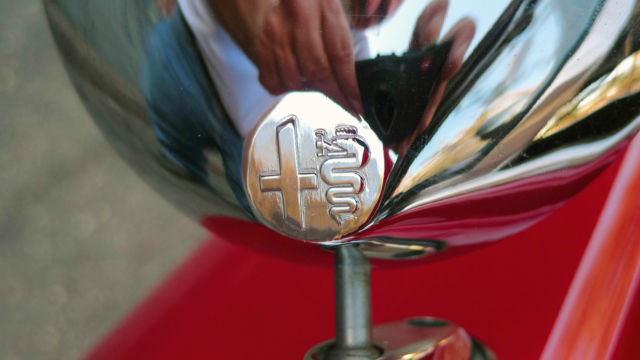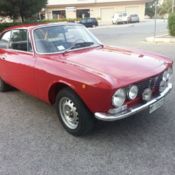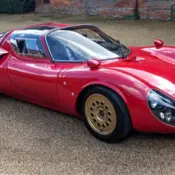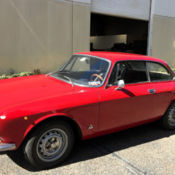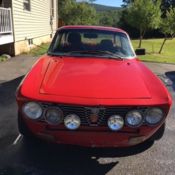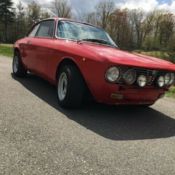|
BACKGROUND:
Little introduction is needed for Alfa's wonderful series of GTA vehicles built from 1965 to 1975. These were a specialderivative of the Tipo 105 Series Coupés that had been introduced in 1963. The main difference was a massive weightreduction program with body panels in alloy and a large number of alloy and magnesium components used throughout thevehicle to bring weight to an absolute minimum. The “A” in GTA stood for the Italian word “Alleggerita” or “lightweight.”Weight reduction was taken to the extreme. For comparison a regular production Giulia Sprint GT had a curb weight of1,130kgs / 2,491lbs while the GTA came in at only 820kgs / 1,810lbs!
Initially there were two basic variations, oth with highly tuned, lassic Alfa twin-cam, win-plug, our-clyinder, n-line enginesand five speed gearboxes coupled to a live rear axle. The “Corsa" or racing version was destined strictly for track and purecompetition use. A more refined and comfortable “Stradale” or road version was also available. 500 examples were completedgiving the car FIA Homologation status as a true “GT” racer and these small and nimble machines immediately provedthemselves more than capable against even the most powerful 5 and 7-liter engined racers of the day.
In order to take advantage of the very popular under 1300cc racing class, n 1968 a GTA Junior version was also put intoproduction. Like the earlier 1600cc version, he new GTA Juniors came in two forms, Corsa for competition and Stradale forroad use. As with the 1600, he new 1300 was an immediate success on the track dominating their class and very often dueto their low weight, xcellent handling and braking took more than a few overall wins from their much larger enginedcompetition.
Official production of the GTA in all variations was slated to end in 1969 however demand from racing teams pushed the AlfaFactory into a difficult position. The GTA had evolved into a potent FIA GR/4 and GR/5 racer in the guise of a heavily modifiedGTAM which featured radically altered body-work and highly tuned 2.0 and even 2.5-liter engines with both injection,mechanical superchargers and later even turbo-charged versions. In order for the GTAMs to continue championship racing inFIA sanctioned events, he GTA road version had to be available as a “production” vehicle available for retail purchase. Inorder to accommodate client needs, he Alfa Factory quietly kept the 1300 GTA Juniors (Tipo 105.59) in production from 1970until 1975 long after the vehicle had been planned to be phased out. Actual production of the steel-bodied production versionended in 1969 when the last of the "step-nose" examples were completed. Those in the “know” however were aware that Alfahad set up a small department of specialist that continued to “hand assemble” GTA Juniors on an "as-needed" bases. Thisloosely met the FIA’s requirement of a production road version available for retail purchase but the true purpose was simplyto keep the racers legal so they could continue racing in championship events.
Almost every GTA Junior built after 1970 went to race teams who immediately gutted them and turned them into GTAMracers. This involved the stripping of front fenders, alences, ront bonnet and doors which were usually then fitted withfiberglass, ure-racing derived substitute components. Radically altered front and rear fenders allowed equally larger wheelsand tires to be fitted. A variety of Alfa derived twin-plug, win-cam four cylinder engines of ever larger displacements werefitted. These now often featured fuel-injection and in several cases hydraulically driven, echanical superchargers and aspreviously noted even turbochargers were adapted. As power and performance went up the need for thin and fragile alloypanels from the original GTA became obsolete and the GTA Juniors were largely assembled with hand-fitted and pop-rivettedsteel panels that were more rigid and far better up to the task and demands of top-level competition. For several years itbecame possible to order a GTA Junior Stradale direct from Alfa Romeo long after the official production version had beenreplaced. A handful of these "Homologation Specials" did not pass into the hands of racers and remained road cars. A total ofjust 193 GTA Junior Stradales were completed making them the rarest version of all of the various GTAs completed. Havingsaid that, oday very few have survived the ravages and nature of competitive racing. Those that did have been in manycases modified far beyond their original delivery configuration. Less than ten of these rare GTA Junior Stradales in theiroriginal "as-delivered" configuration are known to survive to this day. Our subject vehicle is one of those fortunate survivors.
THE END OF THE GTA:
At the end of the 1975 Season, he FIA could no longer look the other way. After ten years of front-line, ompetitive racing itwas clear that Alfa’s small production of hand assembled GTA Juniors were nothing more than a trick to keep the racers “GT”legal. Homologation was ended and Alfa with no announcement completed the final GTA Junior Stradale’s in July of 1975. Afew left over examples remained unsold until December of that year and with the last of them gone, ne of Alfa’s finestchapters in racing came to an end. This also ended Alfa’s tradition and program of providing hand assembled “Piece-Unique”vehicles to special clients on an "as-demand" basis, omething other manufacturers had ceased to do in most cases adecades earlier.
Production of the GTA Junior Stradales from 1970 to 1975 was hardly linear and far from uniform. There are more unknownsthan knows. Production records by chassis number, olor and competition date indicate that initially several Alfa specialistteams built from five to as many as ten examples a month in the first few years, ut by 1974 production had shifted to just asingle specialist team with only a couple of examples being finished each month. The sequence of chassis number andproduction dates seems to make little sense. Here are several known examples by sequential chassis number and productiondate:
AR*776122* Completed July 1974 Sold July 1976
AR*776126* Completed August 4th, 975 Sold September 3rd, 975
AR*776131* Completed July 18th, 975 Sold December 2nd, 975
AR*776139* Completed July 28th, 975 Sold December 1st, 975
AR*776142* Completed November 23rd, 973 Sold November 29th, 973
The small-scale, and assembly, inishing and painting of these GTA Junior Stradale’s was more on the line of a pre-warmanufacturing process. There was no production line. A single team of workers started to assemble a vehicle and finished it.Assembly times varied from as little as a few weeks to several months in some cases, gain always as demand and specificorders for a vehicle came in. Assembly started with a lower steel floor pan to which individual steel and alloy front and rearbulkheads and outer body panels were “pop-rivetted” and bonded into place. Thousands of individual rivets were used toassemble the various panels and little to no attempt was made to hide the crude production method. (A tell-tale sign of anoriginal example is randomly visible rivet heads between various roof, ain-gutter, runk and fender to body seems. Rear andfront bulkhead's will show little attempt to hide the riveted, onded and fastened together panels. Inner panels received littleto no finishing, hile external panels often had an extra layer of body filler, onding compound and paint applied.)
Only two colors were offered, awthorn White and Alfa Red. Even the painting of the completed shells was done by hand withfaults and flaws in the paint the norm rather than the exception. Initially the inner steel and floor pan was made from a verythin metal, ith the outer panels completed in alloy, ut this changed quickly to regular thickness steel when it was foundthat race modifications and racing stressed the panels and floor pans and distorted them badly. Towards the end of productiononly the outer door skins and rear deck lid were still being completed in aluminum… although not entirely as in the case ofAR*776139*, ur subject GTA.
CHASSIS NO. AR*776139*
AR*776139* is sequentially by chassis number the tenth to the the last of only 193 examples completed. It was byproduction sequence number the very last GTA built, o. 193 of 193 total units. It was completed on Monday July 28th, 975and sold new on Monday December 1st, 975. Here are the original production component details which also remain with thevehicle today:
Chassis No. AR*776139*
Engine No. AR00559*05380*
Gearbox No. 22418
Rear Axle No. 10D8 / 3
The exterior color was and remains Alfa Red. No interior color option was available with all examples being completed in blackvinyl with black headliners. With the race homologation withdrawn for the 1976 Season, he Alfa factory had a hard timegetting rid of the final GTA Juniors completed including this particular example. It was not until early December that it wasfinally sold and road-registered for the first time. The original owner or details on the vehicle’s early life not well known. InDecember of 1991 the car was purchased from the original owner near Milan by a Japanese classic car broker. Total mileageat the time of purchase was just 13,900 kilometers. After purchase, he vehicle was sold and exported to a private museumcollection in Nagoya, apan. On arrival in February of 1992 the original Italian road-registration and plates were surrenderedand new Japanese registration was issued two months later in April of 1992. At the time of import to Japan and road-registration, his vehicle had covered only 14,100 kilometers from new. It was little used while in Japan and on July 30th,2014 the officially recorded mileage was now only 18,600 kilometers. The vehicle was offered for sale for the first time everpublicly in the Spring of this year at which time our company quickly arranged for inspections and a subsequent purchase. Atthe time of our initial inspection in February of this year, otal mileage was only 19,328 kilometers. Our inspections revealedthat the vehicle was remarkably well preserved and with the exception of a new stainless-steel exhaust system exactly ascompleted and delivered new in December of 1975. The original owners manual, ales brochure documents, ltra-rare tookkit and original C.C.M unique jack were all still with the vehicle. The original matching number engine, earbox and rear axleassemblies were also still with the vehicle and all were completely stock with no signs of modifications or updates. In May ofthis year the vehicle was exported and shipped to our showroom / shop facilities in San Diego, alifornia where it was issuednew title, icense and registration in our company name.
CHASSIS NO. AR*776139* TODAY:
Our company had previously been involved with a similar GTA Junior Stradale and our friends at Alfaholics in the UKhad provided a generous amount of information on these rare Alfas. I also contacted the AlfaRomeo Factory archivist who provided a wealth of early production details, acts and figures on this and some of the otherknown survivors. Being the last production sequence example completed, e anticipated that the vehicle would have thestandard thickness steel floor pan, ulkheads and outer panels with the doors and rear deckled in aluminum. We were quitesurprised however to learn that the entire body, ear bulkhead, oors, eck-lid and many other panels were in thin gaugealloy rather than steel. On top of that, he steel floor pan, ront wings and inner panels were the earlier “thin” 1mm typefound usually on the early GTA variants. Here is a list of the alloy panels found on this particular vehicle:
-Doors
-Roof
-Rear Fenders
-Rear Deck Lid
-Rear Valence
-Rear Bulkhead
-Front Upper Bulkhead / Scuttle
-Radiator Shroud and Support Structure
In addition to all of these alloy panels all of the structural bulkheads and other panels the thin 1mm steel type. Numerousother light-weight items are also present in the vehicle everywhere you look. The dash panels is made of pressed cardboardwith vinyl wood appliqué. There is no radio bracket and it has an Alfa radio-delete plate fitted to the dash. Surprisingly, hisAlfa still retains the original pencil-thin, urely decretive bumpers front and rear as well as thin alloy trim throughout. All ofthe glass appears to be original and bares the date codes of October and November 1968 as testament to this. The mirrorsare both the early “Alfa” embossed in-house ones used specifically on these vehicles. The interior seats, rim, arpeting anddashboard cover are all completely original and without signs of damage or wear or UV exposure. The rear seats appearnever to have been sat in. The gauges are the unique 8,000RPM / 200KPH type found only on these GTAs and incredibly, hesteering wheel is still the ultra-rare and unique, our-hole, ix-bolt “HELLEBORE” Type that today is simply impossible to find.(One on Ebay sold for $3,200 in March of 2014.) The original key and numbered tumbler remains with this vehicle 40 yearsafter it was completed. Engine compartment details appear lifted directly from the original FIA Homologation photos. Allcomponents, it, inish and detail are “as-new” in in their original completion and delivery configuration. The correct Weber45mm carburetors, ntake manifold and unique air-box, ilencer and filter assembly are simply perfect. The engine has onlybreak-in time and features the original and correct early version, win-plug cylinder head with correct original type valvecovers. The original, lose ratio gearbox, nique final drive assembly, ront and rear brakes and “5A” rear suspension set-upwhich is also unique to these GTAs is all still present and in as delivered new configuration. The gearbox as with the enginehas break-in time only on it.
After arrival at our shop the carburetors and rare, win-plug ignition system were completely overhauled. the rear axle waslikewise completely disassembled and rebuilt as were the brakes. New tires were fitted and the vehicle completely safetychecked with all services and maintenance checks brought current and up to date.
It cannot be emphasized enough how exceedingly rare and unique these late production GTA Alfas are. To find such an example so carefully and conservatively preserved is nearly impossible. Only 193 of theseAlfas were ever built. They were as such the very rarest of the GTA variants produced. Today only a handful of original un-raced "Stradale" versions are known to still remain. This particular example has only19,640 original kilometers from new and it is completely matching numbers, ully restored and totally rust as well as accident free. More than 200 high resolution inspection photos and copies of the original factory assemblyrecords as well as sample copies of additional records and documents related to this vehicle can be accessed by contacting me at bill AT billnoon DOT com or by phone at 619 840 7811
Please feel free to contact to arrange for inspections and test drives. I can assist with full door-door delivery anywhere in the world. EEC import is pre-approved at only 5% VAT and no additional duty charges.
Many thanks for your time and patience and good luck in all your automotive searches,
Bill Noon
Symbolic International
11425 Sorrento Valley Road
San Diego, alifornia 92121 USA
Phone 619 840 7811
bill AT billnoon DOT com
|
 Home
Home Contact us
Contact us NEWEST CARS
NEWEST CARS SELL YOUR CAR
SELL YOUR CAR FAQ
FAQ







